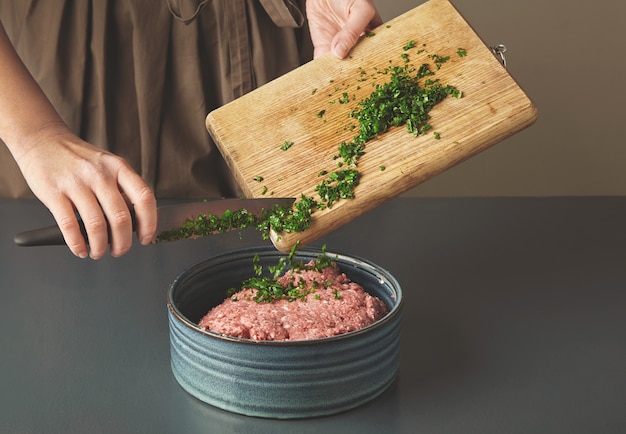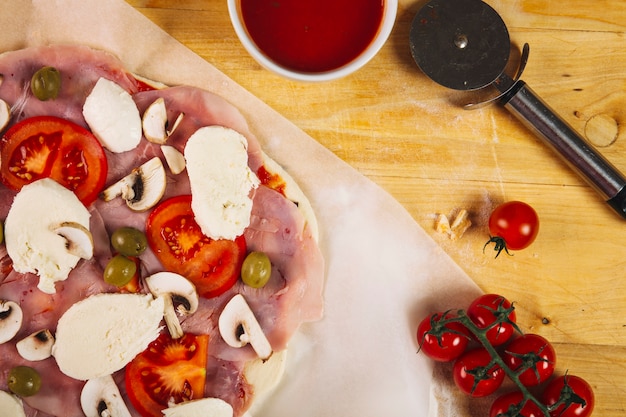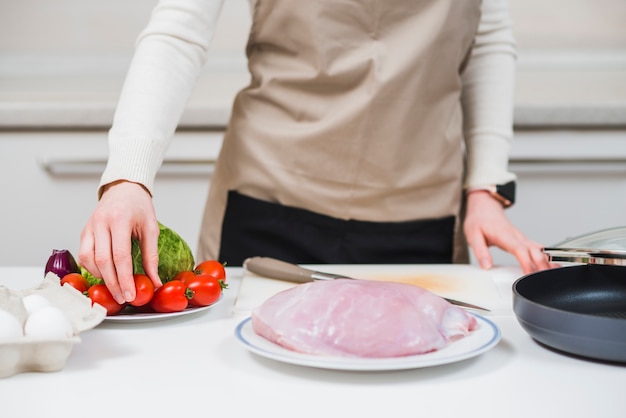As a seasoned food enthusiast, I've always loved the comforting aroma of a perfectly cooked spiral ham wafting through the house, especially during holidays and family gatherings. It's a dish that brings people together, and there's nothing quite like the joy of carving that beautiful, glistening ham, revealing layers of succulent, juicy meat. Over the years, I've learned a few tricks to ensure my spiral ham always comes out perfectly cooked, and I'm excited to share those secrets with you.
Part 1: Choosing the Right Ham – The Foundation of a Delicious Dish

The journey to a delicious spiral ham starts long before you even turn on the oven. Choosing the right ham is crucial. It's like picking the perfect canvas for a masterpiece; the quality of your ham will heavily influence the final outcome. Let's delve into the key factors you should consider when selecting your ham.
types of ham: Understanding the Differences
At the supermarket, you'll encounter two main types of ham, each with its own characteristics:
- bone-in ham: These hams retain their bone, which adds a lovely depth of flavor and helps keep the meat moist during cooking. They're usually larger, requiring longer cooking times. Picture a hearty, rustic ham that's perfect for a large gathering.
- boneless ham: These hams have the bone removed and are often pre-sliced, making them super convenient for carving and serving. They typically cook faster than bone-in hams, making them ideal for smaller gatherings or when you need a quicker meal. Think of them as the streamlined, user-friendly option.
Curing and Smoking: The Flavors That Define a Ham
Hams go through a curing process, a vital step that gives them their unique taste and pink color. Salt, sugar, and sometimes other spices are used to preserve the meat and create that characteristic ham flavor. Some hams are also smoked, adding an alluring smoky aroma and depth of flavor. The curing and smoking processes create a symphony of tastes that define the ham's character.
Choosing the Size and Weight: Getting the Right Amount for Your Needs
The size of the ham you choose directly impacts the cooking time. For a small gathering, a 4-6 pound ham might be just right. But if you're expecting a crowd, you'll want to go for a larger 10-12 pound ham to ensure there's enough for everyone. Don't forget to consider the number of guests you'll have to make sure you select a ham that's big enough to satisfy everyone's appetite.
Part 2: Preparing the Ham – Setting the Stage for Success

Once you've chosen your perfect ham, it's time to get it ready for cooking. This preparation stage is crucial because it enhances the ham's flavor and helps ensure it cooks evenly. It's like prepping a canvas before painting – getting it ready to receive the masterpiece you're about to create.
Removing the Packaging: Unveiling the Ham
First, carefully remove the ham from its packaging. Some hams are wrapped in a protective plastic film that can be easily peeled off. Others might be encased in a netting that needs to be removed before cooking. Remember to gently remove any packaging to avoid damaging the ham.
Scoring the Fat: Opening the Doors to Flavor
Scoring the fat on the ham helps it cook more evenly and allows the flavors to penetrate deeper. Imagine it as creating little pathways for the heat and flavors to travel, ensuring a succulent and evenly cooked ham. Use a sharp knife to make shallow cuts, about 1/4 inch deep, across the fat. This not only helps the ham cook more evenly but also creates a beautiful, criss-crossed pattern that adds visual appeal to the final dish.
Preheating the Oven: Setting the Right Temperature
Preheat your oven to 325°F (160°C). This step is essential for consistent cooking and ensures the ham reaches the desired temperature. It's like preparing the stage for your culinary performance, making sure the environment is perfect for a successful outcome.
Part 3: Cooking the Ham – Bringing the Flavors to Life

Now comes the heart of the process: cooking the ham. This is where the magic happens, transforming your chosen ham into a delicious centerpiece for your meal. Follow these guidelines to ensure your ham cooks to perfection.
Cooking Time: Finding the Perfect Balance of Time and Temperature
The cooking time for a spiral ham varies depending on its weight. Here's a handy guide to help you estimate the time needed to cook your ham to perfection:
| Weight of Ham (lbs) | Cooking Time (hours) |
|---|---|
| 4-6 | 1.5-2 |
| 6-8 | 2-2.5 |
| 8-10 | 2.5-3 |
| 10-12 | 3-3.5 |
Remember that these are just estimates. It's always a good idea to check the internal temperature of the ham with a meat thermometer to ensure it's cooked through. It's better to err on the side of caution and ensure your ham is safe to eat.
Cooking Methods: Choosing the Right Technique for Your Needs
There are several ways to cook a spiral ham, each with its own advantages and drawbacks:
- Oven: The most common method, this allows for even cooking and a beautiful glaze. It's a tried-and-true technique that delivers consistent results.
- slow cooker: For a hands-off approach, you can cook the ham in a slow cooker on low heat for several hours. It's perfect for busy days when you want to let the slow cooker do the work. Just set it and forget it!
- Air Fryer: If you're looking for a faster cooking method, an air fryer can be a great option. It cooks the ham quickly and gives it a crispy exterior. It's perfect for smaller hams or when you need a quick and easy meal.
Glazing the Ham: Adding a Touch of Sweetness and Shine
A glaze adds a beautiful shine and intensifies the flavor of the ham. It's like adding a final touch of artistry to your culinary masterpiece. You can use store-bought glaze or make your own from brown sugar, mustard, and other spices. For a truly delicious glaze, I like to add a touch of honey or maple syrup. Apply the glaze during the last 30 minutes of cooking, brushing it on every 10 minutes to create a lovely caramelized finish. This glazing process creates a beautiful, glossy finish that will have everyone drooling over your ham.
Part 4: Checking for Doneness – Ensuring Safety and Quality
Ensuring your ham is cooked thoroughly is crucial to avoid any foodborne illnesses. The USDA recommends a safe internal temperature of 145°F (63°C) for ham. Here's how to check if your ham is done and ready to eat.
Using a Meat Thermometer: The Gold Standard for Accurate Cooking
The best way to check for doneness is to use a meat thermometer. It's a simple yet essential tool that gives you a clear and accurate reading of the ham's internal temperature. Insert it into the thickest part of the ham, making sure it doesn't touch bone. Once it reaches 145°F (63°C), the ham is ready to be enjoyed. Using a meat thermometer takes the guesswork out of cooking and ensures your ham is cooked to a safe temperature. It's a small investment that pays off in peace of mind.
Visual Cues: Recognizing the Signs of a Perfectly Cooked Ham
While using a thermometer is the most reliable method, you can also look for visual cues. A perfectly cooked ham should have a golden-brown colour, and the juices should run clear when you pierce it with a fork. These visual clues can help you determine if your ham is cooked through, but always rely on a meat thermometer for the most accurate reading.
Part 5: Resting and Carving – Preparing the Ham for Serving
After the ham is cooked, it's essential to let it rest before carving. This allows the juices to redistribute throughout the meat, resulting in a more tender and juicy ham. Imagine it as letting the flavors settle and meld, making the ham even more delicious.
Resting Time: Letting the Flavors Settle
Let the ham rest for at least 15 minutes before carving. You can cover it loosely with foil to keep it warm while it rests. This resting period allows the juices to be reabsorbed into the meat, creating a tender and moist ham. It's like giving the ham a chance to relax and recover after its culinary journey.
Carving Tips: Transforming a whole ham into Delicious Slices
When carving a spiral ham, start by slicing against the grain, working your way down the spiral. This helps create tender and flavorful slices. Be sure to remove the bone as you carve. You can also slice the ham into thin, even pieces for easy serving. The key is to work slowly and carefully to avoid any accidents. Carving a spiral ham is like a dance, with the knife moving gracefully through the meat, revealing the layers of deliciousness.
Part 6: Serving the Ham – Creating a Feast for the Senses
Now that your ham is cooked, rested, and carved, it's time to serve it up! Here are some ideas to make your ham the star of the show and create a truly memorable dining experience.
Accompaniments: Balancing Flavors and Textures
Spiral ham pairs well with a variety of accompaniments, such as:
- mashed potatoes: A classic comfort food that complements the salty ham with its creamy texture and subtle sweetness.
- green beans: A fresh and vibrant side that adds a touch of colour and a refreshing contrast to the richness of the ham.
- sweet potato casserole: A sweet and savory side that balances the salty ham with its warm and comforting flavors.
- Macaroni and cheese: A creamy and cheesy side that everyone loves, providing a comforting and satisfying element to the meal.
- Fresh fruit salad: A refreshing and light side that adds a burst of flavour and a touch of sweetness, offering a palate cleanser between bites of ham.
Serving Suggestions: Presenting a Culinary Masterpiece
Serve the ham warm with your chosen accompaniments. You can also arrange the ham on a platter, surrounded by the sides. For a more elegant presentation, carve the ham into thin slices and serve them on individual plates. No matter how you choose to serve it, remember to present your ham beautifully to enhance the dining experience.
Part 7: Leftovers and Storage – Maximizing Your Culinary Investment
With a delicious ham like this, leftovers are inevitable! But don't fret – leftover ham is a culinary treasure that can be used in many delicious ways. Here's how to make the most of your leftovers.
Storing Leftovers: Keeping the Flavor Intact
Refrigerate leftover ham in an airtight container for up to 3-4 days. You can also freeze leftover ham for up to 2-3 months. Freezing is a great way to preserve your ham's flavor for later use. Just remember to thaw it completely in the refrigerator before using it.
Using Leftovers: Transforming Leftovers into New Dishes
There are endless possibilities for using leftover ham. Here are a few ideas to spark your culinary creativity:
- ham and cheese sandwiches: A simple and satisfying way to enjoy leftover ham, perfect for a quick lunch or snack.
- Ham and bean soup: A hearty and flavorful soup that's perfect for a cold day, using leftover ham to add depth of flavor and richness.
- Ham salad: A delicious spread that can be served on bread, crackers, or as a topping for salads, adding a touch of savory flavor to your dishes.
- Ham and potato hash: A savory and satisfying breakfast or brunch dish, using leftover ham to add protein and flavor.
Part 8: FAQ – Answering Your Questions About Spiral Ham
Here are some frequently asked questions about cooking spiral ham:
1. What is the best way to glaze a spiral ham?
You can use a store-bought glaze or make your own. A simple glaze can be made with brown sugar, mustard, and spices like paprika, garlic powder, or black pepper. For a more complex glaze, you can add honey, maple syrup, or fruit juice. Experiment with different flavors to find your favorite glaze combination.
2. Can I cook a spiral ham in a slow cooker?
Yes, you can cook a spiral ham in a slow cooker. Just place the ham in the slow cooker and cook on low heat for 6-8 hours. You can also add a cup of water or broth to the bottom of the slow cooker to prevent the ham from drying out. slow cooking is a great hands-off method that allows the ham to become incredibly tender and flavorful.
3. How do I reheat leftover ham?
You can reheat leftover ham in the oven, microwave, or stovetop. For the oven, preheat to 325°F (160°C) and bake for 15-20 minutes. For the microwave, heat on high for 1-2 minutes. For the stovetop, heat over medium heat in a skillet with a little bit of butter or oil until heated through. Choose the reheating method that best suits your needs and preferences.
4. Can I cook a spiral ham from frozen?
It's best to thaw the ham completely before cooking. You can thaw the ham in the refrigerator for 3-4 days or in a cold water bath for 3-4 hours. Thawing the ham completely ensures that it cooks evenly and safely.
5. What are some tips for carving a spiral ham?
Start by slicing against the grain, working your way down the spiral. Be sure to remove the bone as you carve. You can also slice the ham into thin, even pieces for easy serving. Carving a spiral ham can be a little tricky, but with practice, you'll become a pro. The key is to be patient and work carefully to avoid any accidents.
Part 9: Final Thoughts – Embracing the Art of Ham Cooking
Cooking a spiral ham might seem daunting, but it's really quite simple. With a little planning and the right techniques, you can create a delicious and impressive dish that everyone will love. It's a culinary journey that can be enjoyed by all, bringing people together around a shared meal. So go ahead, grab a ham, and give it a try! You won't regret it. Embrace the art of ham cooking and create culinary memories that will last a lifetime.
Everyone is watching

Perfect Rice Every Time: The Ultimate Guide to Cooking Rice
Cooking TipsAs a self-proclaimed foodie, I've always been a bit obsessed with rice. It's the foundation of countless cuisi...

The Ultimate Guide to Cooking Asparagus: Tips, Techniques, and Recipes
Cooking TipsAsparagus. The mere mention of this spring delicacy conjures up images of vibrant green spears, crisp and burs...

Ultimate Guide to Cooking the Perfect Thanksgiving Turkey
Cooking TipsThanksgiving. Just the word conjures up images of overflowing tables laden with delicious food, the scent of r...

Prime Rib Roast Cooking Time Chart: Per Pound Guide
Cooking TipsPrime rib roast. Just the name conjures images of lavish dinners, crackling fires, and hearty laughter. It’s ...

Can You Cook Spaghetti with Gasoline? (The Shocking Truth)
Cooking TipsWe've all seen those crazy internet trends. You know, the ones that make you wonder, "Did someone actually try...
